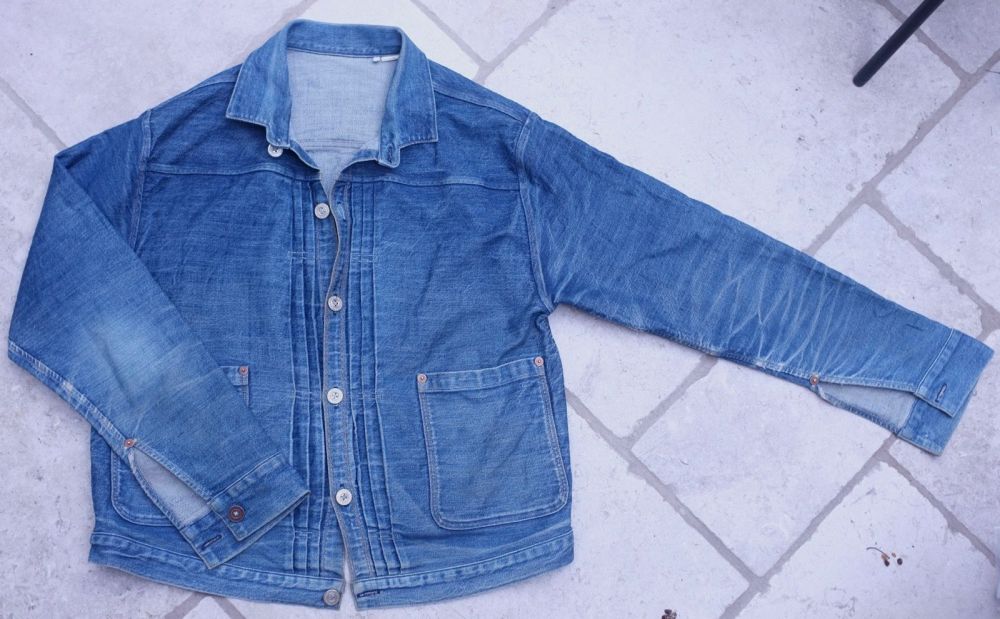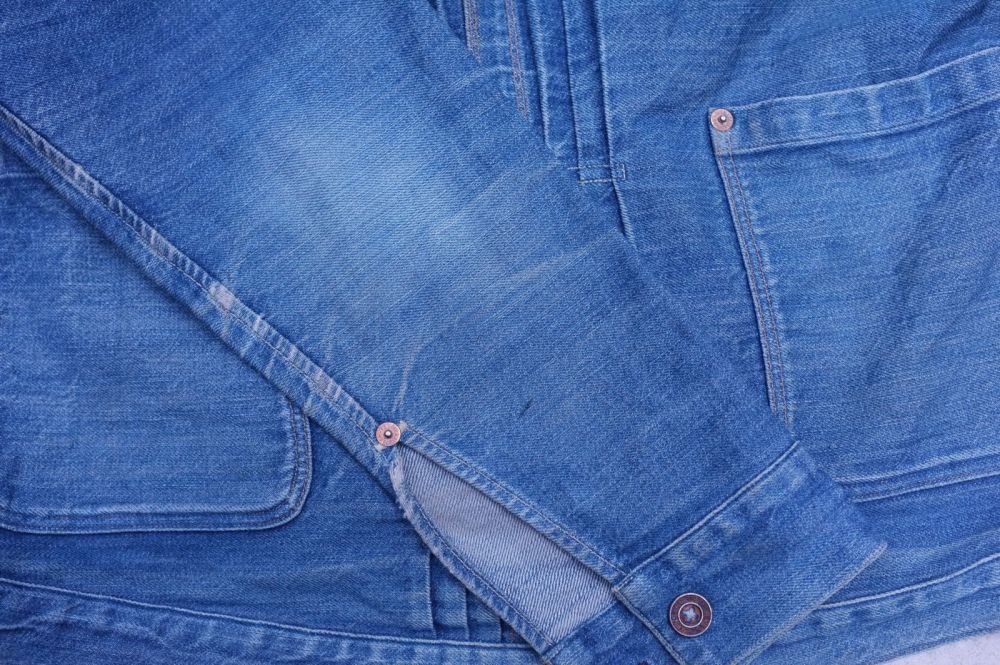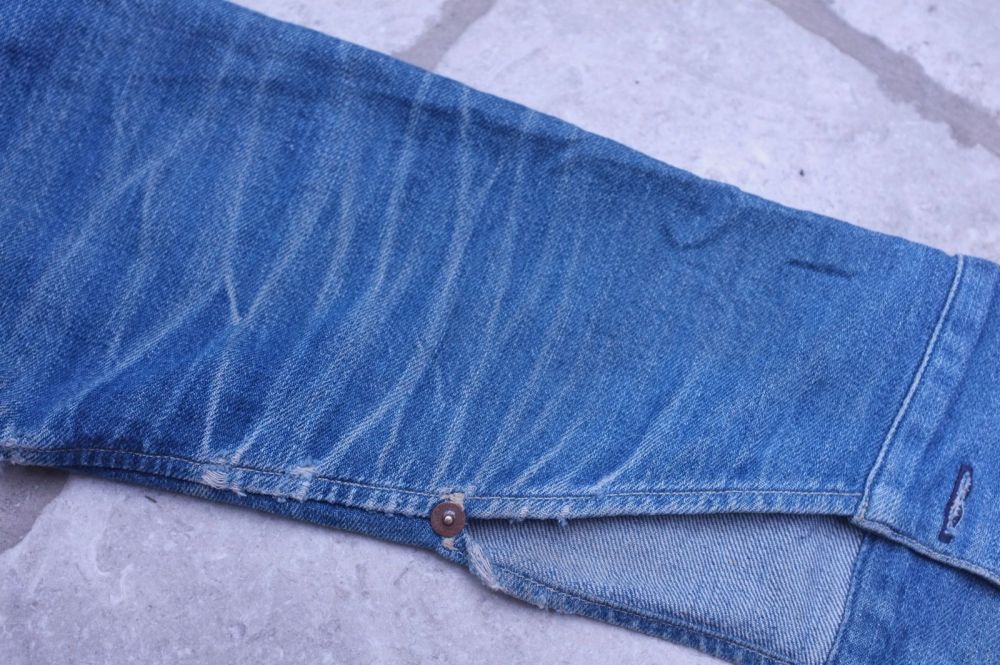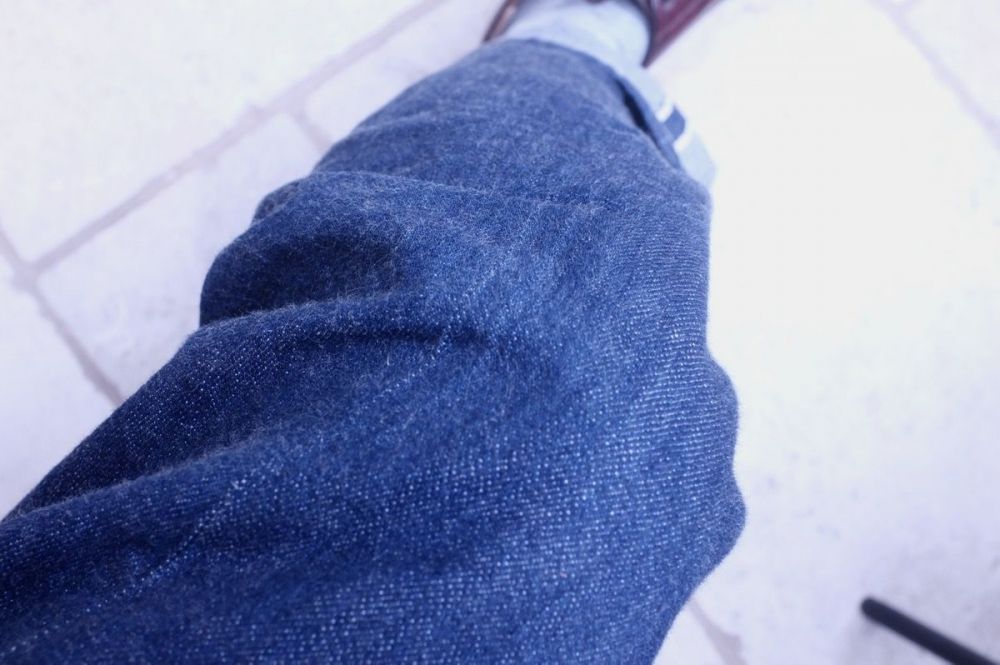-
Posts
5608 -
Joined
-
Last visited
-
Days Won
39
Content Type
Profiles
Forums
Events
Gallery
Store
supertorial
Classifieds
Posts posted by Paul T
-
-
NO! These are 40s jeans not 60s ones. I don't want my left testicle to be dressed like someone playing CoD.
3 -
18 minutes ago, Duke Mantee said:
Normally selvage would come narrower than non-selvage and I think White Oak was 28” in the early years so for a yard length we have 1008 sq in, and a square yard would be 1296 sq in - that’s 29% more area therefore 29% more ‘weight’ ... so 9oz becomes 11.5oz. That’s what’s directed in Circular No.266 I posted above. Then I guess you might want to consider shrinkage or was the denim pre shrunk?
However I think that’s what you’re supposed to do before you quote or advertise the ‘Weight per Square Yard’ of your fabric - so it seems to me what’s being argued is that Levi’s ignored that directive and quoted weight by the linear yard?
That's my understanding.My recollection from Ralph is that there was only minimal change in weight. I think Levi's stating 'bigger' figures in the 40s and so was probably marketing-led (alongside a different terminology on linear vs square yard). He was talking specifically about the Cone years, from 1927 on, so he meant that the 10oz and 12.5 oz are likely the same weight. Don't know about the earlier, Amoskeag denim but it's possible that's the same issue. Amoskeag definitely used different looms though - less efficient ones with a manual shuttle change.
It's interesting TCB weighed the fabric as 14oz. From what I know the standard at Levi's has always been 12.5 which when shrunk down is 14oz per square yard. But when manufacturers give weights they must surely be nominal. THe yarn you use, how it's spun, and how tight the weave is must all make a considerable difference.
For those who haven't seen it, I just relocated this interview with Ralph with good Cone dtuff.10 -
Ralph Tharpe, perhaps the biggest expert on vintage denim (the fabric) believes earlier Cone fabric was indeed the same weight as later.
Weight is nominally per square yard but Cone's earlier fabric was a slightly narrower bolt. That explains the disparity in weight.8 -
15 minutes ago, volvo240thebest said:
it didn't sound at all like bullshit! I am all for diversity and I have always looked with interest at your approach actually.
for the sake of variety, why not. After all is the wearer that decides how to wear his/her jeans. I am deffo more into keeping it nice and simple and not overthink it, and think that the frequent wash it's the most accurate way to wear in jeans....
by the way, as we speak of this, it comes to my mind that @Paul T never ever disclosed information on his fading methods...
Haha!
All my jeans end up looking the same. I tend to hold off for four-five months for the first wash. Not because I think the eventual fade will be better but because I like the look and crispness of new jeans. That's it. Used to wash with Dr Bonner but now I use regular non bio, 30 degrees. Usually I wash them right way round as I like marbling. Spin and line dry. I would never, ever use a dryer as those fuckers kill the planet.
I've seen all the folks trying complicated stuff and that's fine. Do you remember all the bollocks with people using vinegar and salt on their jeans? I'm surprised by the Japanese approach with starch, as a new thing, because I like my jeans to fade slowly. Starch can be useufl as as dirt screen though - that's what cowboys used to do.
I love TCB to bits but honestly, in my ideal world they would have denim that fades just a bit slower.
tl;dr: I'm old and not in a hurry, I have a Japanese wisteria and it took that fucker NINE YEARS to flower.13 -
9 hours ago, Graytrain said:
The fuck is this?? I've never heard of that process. Is that how they get those perfect lap fades? I've always wondered. I never get any honeycomb like fades on the lap.
This was used quite a lot in ancient superfuture. It simply makes the whiskers sharper and crisper so more indigo chips off. You also get more of the little holes in the honeycombs as the fabric becomes more brittle. I have also seen 'pinched' fades are still fashionable in Japan, where you pinch the creases regularly to fade the highlights. That gives thinner whiskers and you don't get the rippled shading nearby . Overall if you add some starch, it can give more contrast a bit like if you wear your jeans raw, or sanforized unsoaked, but there's always a trade-off.
1 -
-
18 hours ago, erk said:
I ordered 31 OW. I have a size 32, 31, and 34 TCB 50s. The 31 feels best on me so I went with that.
I also own a sz 32 sugar cane 1947 - I would defintely not get a 31 in those - that waistband is pretty snug.
I wear a 32 in earls apparel stuff - gung ho camp trousers and fatigue pants
32 in LVC 1955 - Wish I had gone with 31 on these. But the measurements on the 32 1955 are pretty similar to the sizing chart for the s40's on TCB's site.
I am following Erk. I'm 32 in the TCB 50s (roomy, lower shot), 31 20s (top shot, as far as I remember they were trim but not tight), 32 60s. I found SC Edo Ai 31 too small. Ryo thinks 31 will be ok although Inoue-san might disapprove. SO i think I'll go 31. Do you think that's reasonable, @erk?
Update: Done. 31/30. No stacking for me. Ordered raw so I can stretch waist if necessary.6 -
Yup. Those are the mythical 701. THey're very interesting. The first Japan reissue Levis (pre-LVC) were 502, I think the 701 came soon after, was issued in a box and they were also exported overseas (maybe just Europe, I saw them in London at the time). I have NO Idea why they were badged as 701. Later they badged them as 702, which would have been a kids' size. They are a kind of fantasy, what might have been repro as no original Levi's had the cinch in that location. They also inspired a lot of early fakes! , I did have lengthy email exchanges with a Levi's Japan founder but he coudnlt' tell me what the inspiration was for this model and why they named it 701. My guess is it's like LVC naming the 1937 501 as the '201, they wanted to have different lot numbers to differentiate.
If other folk don't know, these predate LVC. There were a few US-made Capital E repros from 1990 on, and the Levi's Japan, from 1987 on (around the time Evis started up), were entirely separate using only (in the early days) Japanese fabric.
Very interesting snippet of history, from the very beginning of the repro era, nice catch!
Can i use the pix on my loomstate blog please? Then I can refer to this info later.8 -
The 201 are indeed lovely jeans (and fabric). The denim comes from Kurabo. Very hard to wear-in but look great all the way. I have maybe a year's wear on mine and am looking forward to returning to them some day. I am fairly certain the 701, nice jeans also, has fabric from Kaihara for the production runs i know of.
Lady Levi's were Sanforized from the late 30s on but for some reason Levi's would always call them "Pre-shrunk", probably because Sanforized fabric was associated with rivals like Lee and Wrangler. These, and the repros, had pink not red selvage I think.
Those 701, however, look different to me from the ones I know from the Lady Levi's. the cinch is in the wrong place as far as I can see. Can we see the tags?
I know there were some strange, very early 'repro' 701 in the late 80s/early 90s that were actually men's jeans with the wrong tags, they're pictured in the French Gilles l'Hote denim book. They were tagged 701SSX . I think at this early stage people didn't know the 70s was a women's jean. There was a similar Japanese version in the 90s, tagged as a 702. Both had the unusual cinch placement . Would love to see more pix!2 -
Does anyone have the 50s and 20s size charts for ours to hand?
0 -
14 minutes ago, jewellben said:
I've never bought one wash jeans, silly question time....do they shrink anymore like unsanforized do for the first few washes?
They don't seem to, no, going by my Full Count and Sugarcane that were one wash. Of course waist will stretch out typically an inch.
2 -
5 minutes ago, bartlebyyphonics said:
great to see you too sir paul!
part-time might mean you give us some of a chance!
torn between 36 and 38 waist: the gods of stretch will be a deciding factor in choice; oh what gifts must I sacrifice for an augur...
(or to think of different wearing strategies; low wash, hand stretching waist if needed w. clean fit across hips vs. multi-wash and comfort but possible bag ... my old tcb 50s tagged w.36 worn/washed/stretched few years wear now measure 46/92cm waist but def feel too trim these days ... but if the 38 end up stretching back to original that won't be good neither... [processing...] )
I'm thinking I'll just go for the size I had for the 20s. Otherwise I will have to find all the original sizing charts and it will make my brain hurt. Although it would be good to know if this fabrics shrinks/stretches more than, say, the 20s. Do we have any clues, yet?
1 -
2 hours ago, beautiful_FrEaK said:
I tried to bring up the denim itself and the looms it is created on.
That one got shut down pretty quickly. But I still think, if we are so obsessed with the correct sewing machines and production techniques, why are we so uninterested in how the denim was made?
That is strange, I know. Whatever people's thoughts of Cone, that was the only 40s denim where the yarn was specifically designed for the fabric. Every other manufacturer that I know of simply chooses from a selection of yarns (or, for most, fabrics). I never really got into the details of the dye jobs at Cone, and why some shades pre-sulphur vary as they fade. I was interested that TCB use a less white cotton for the fill yarn, others have actually (though they don't tell you usually) tinted the cotton for a more ecru shade.
all that said, as pointed out, in earlier denim one key factor was variability. I don't know for sure whether they blended their cottons in the 40s but I would be pretty certain they didn't, as that produces delays in the supply chain. You will get massive variations year to year simply if the plants are bigger, as there will be important differences between average staple length depending on weather that year. That variation alone will probabyl be bigger than any other 40s vs 50s differences.
Overall, though, for me it's the different shading and texture as they age that makes me love jeans or not and gives them a lot of their character. My Lot 1 Levis' were cut after a couple of vintage 60s pairs, obviously tailored to me, and after a year I've dropped them, I just can't stand the exaggerated repetitive slubbing.5 -
Great to see you Bartles.
I'm in of course. Part-time contestant.
I'll send volvo an 18-page detailed sizing questionnaire then go for 32 like I have for the last 20 years.5 -
TCB
in superdenim
Looking great. Thanks for all this, Volvo.
I especially love the super-pale stitching of Levi's from this era and look forward to wearing them.
Do you have a photo of the 'stagger' - the bottom of the V of the yoke - on the vintage pair?
It's a constructional detail that wasn't quite right on the 50s I think (only matters to freaks like me, my 555 LVC had the same error). Levi's themselves did change construction quite randomly, the 40s was a period when it moved from one style (parallel lines of stitching line up, as one the repro pair here) to another (the right hand parallel lines are slightly higher, which makes the yoke effectively more symmetrical, as on post 47 Levi's) and I'd be interested to see what's on the reference pair .3 -
TCB
in superdenim
Ah. I sized down an inch in the 20s compared to the 50s because I thought the seat was wider. Sorry to bore you, is that appropriate here? Do we have a clue of seat, thigh and leg opening vs the 50s?
( I am owed by the way, I've done a decade of helping LVC folks size their 47 vs 55, I must surely be able to cash in my karma).1 -
TCB
in superdenim
4 hours ago, aho said:If Sir Paul T joins and decides to become a phys ed teacher instead, we're all doomed

If you've seen my skinny legs surely you will know that I'm teaching electric circuits, stretching springs and colliding trolleys. And no denim at work! Mind you I have negotiated a three day weekend to ensure I come ahead of Volvo and his Dremel.
2 -
TCB
in superdenim
-
That's pretty typical fading for four months. Those jeans don't go down easy.
1 -
Gave my three-pleat a hand wash last week as the weather was sunny.
It's been interesting wearing this alongside, for instance, the TCB 20s - although they're 40 years apart in Levi's terms the fabric isn't that different. I love the shading on the TCB, as in the range of colours. I've also been wearing some Levi's Lot 1 with Nihon Menpu fabric. I think the Cone 1880s fabric, in terms of texture, is so far ahead it's unreal. Much much more subtle, rather than pronounced bumps and slubs there are myriad small variations in the fabric.I prefer the dye job on the TCB in terms of looks, as I like high contrast, but I think we'll look back on this era of Cone fabrics as being pretty unique
. It's certainly much better than the Kurabo fabric replicating the same era - I am not sure if the pre-20s fabric for current LVC is from Kaihara, i'd be very interested to see their interpretation of the same fabric.
All these shots are a bit pale, my Fuji X100 doesn't seem to get denim colours right, unlike my wife's sony RX (which I, um, dropped and killed).


Finally, here's the 1880s natural indigo with a proper camera. Very dense and scrunchy with lots of fluff. They're about a shade darker in real life with more of a red-purple hue.
As you can see, the busted seam is very close to my knee, then swings round to line up with my laces at the bottom. the most leg-twist I've had from a first wash, ever. 16
16 -
TCB
in superdenim
Honestly, let's not go there. If anyone's bothered they can make their own stencil. If the design looks vageuly levi's ish, they might hassle Inoue-San, and the people who own Evisu are absolute arseholes and there's a chance of them weighing in, too. Better to spend out energy on a nice leather patch and some groovy cotton ticking for the pockets.
13 -
They've got the most extreme leg twist of any jeans I've owned. Sitting down now to drink my coffee the selvage is past the front line of the jeans, ie more than 45 degrees. Same with the shrinkae on length and waist, way more than the Roys.
Colour's a good bit darker than this photo, which doesn't show the really extreme crinkling and little bumps, way more than anything I've seen (although these days I tend to put thru wash rather than soak). Being a slimmer fit they're maybe not as good summer jeans as the 1890s and their predecessors, the 1901. but I'm committed now...4 -
- Popular Post
- Popular Post
and post wash.
Two different interpretations of an 1800s fabric, with key similarities but also big differences.
The Kurabo is very green, which we associate with natural indigo. These are a bit like the 201 fabric, very hard to wear in, with very turquoise mid tones. But these have a much much finer yarn.
The 1880s fabric is fascinating, as it really is natural indigo, grown in Tennessee, but is a much more red or even purple hue - like we'd associate with synthetic. It's very fluffy, crinky fabric. You'd expect this to have a similar texture to the Roy Contest loomstate, which was loomstate based on a similar yarn design, but this is fluffier and crinklier. almsot certainly some of this is down to the variations of the cotton, year on year.I love the combination of very fine yarn and very fine stitching. It's one detail that LVC get right. The stitching seems to sink right into the denim, and I lvoe the muted effect in the 1890s.
if these are like the 3-pleat jacket, or my old SDA natural indigo which had a fiarly similar hue, these will be absolute bastards to wear in. So i'll see y'all in 10 years. Dr Heech won't know, but I've executed a career swerve to being a teacher. So most of the year denim is weekend only, but for the summer I'll be clad in these babies, 7 days a week.
27 -
- Popular Post
- Popular Post
On 5/21/2020 at 5:01 PM, andyrcii said:The people who buy these things never even wear them, they just keep them in the bag forever.
The smart ones probably do. But not me.
So, these are the 1880s natural indigo. For me they are the last great LVC.
FOr all their many faults, there was some great work going on, especially from Cone. To think someone grew the indigo, experimented with dyeing, then developed a fabric from scratch for a run of a few 100 jeans is pretty much insane.
I put them in a 30 degree wash wihtout soap to shrink them down as I know, being loomstate, these will shrink a lot.
At the same time I hand-washed my 1890s then shoved them in the wash with the 1880s. these are the version with Kurabo fabric. Some weird odddities, like a paint finish on the buttons, but some great features, like the very agricultraul rivets. I was alerted to these jeans on sale very early in this thread. £75. THat was probably 12 years ago or more. I have worn them every summer bar the last one, light jeans being perfect for the hot weather. After maybe 10 months of wear, they are starting to look broken-in.
29














.thumb.jpg.ea38056189edebc64c35d977dcb0484d.jpg)





Happy jeans: TCBxSufu S40s WW2 contest thread
in superdenim
Posted · Edited by Paul T
For reference: random is random and I will live with whatever I get. Just putting my opinion out there, my testicles should be fine.
Sorry Volvo, I wasn't moaning - just arguing!
I have a neighbour who has a fucking Waffen SS pattern winter jacket, just don't swap it for that even if it is contemporaneous.
But I can't call him on it, can I, because even recognising the pattern incriminates me.